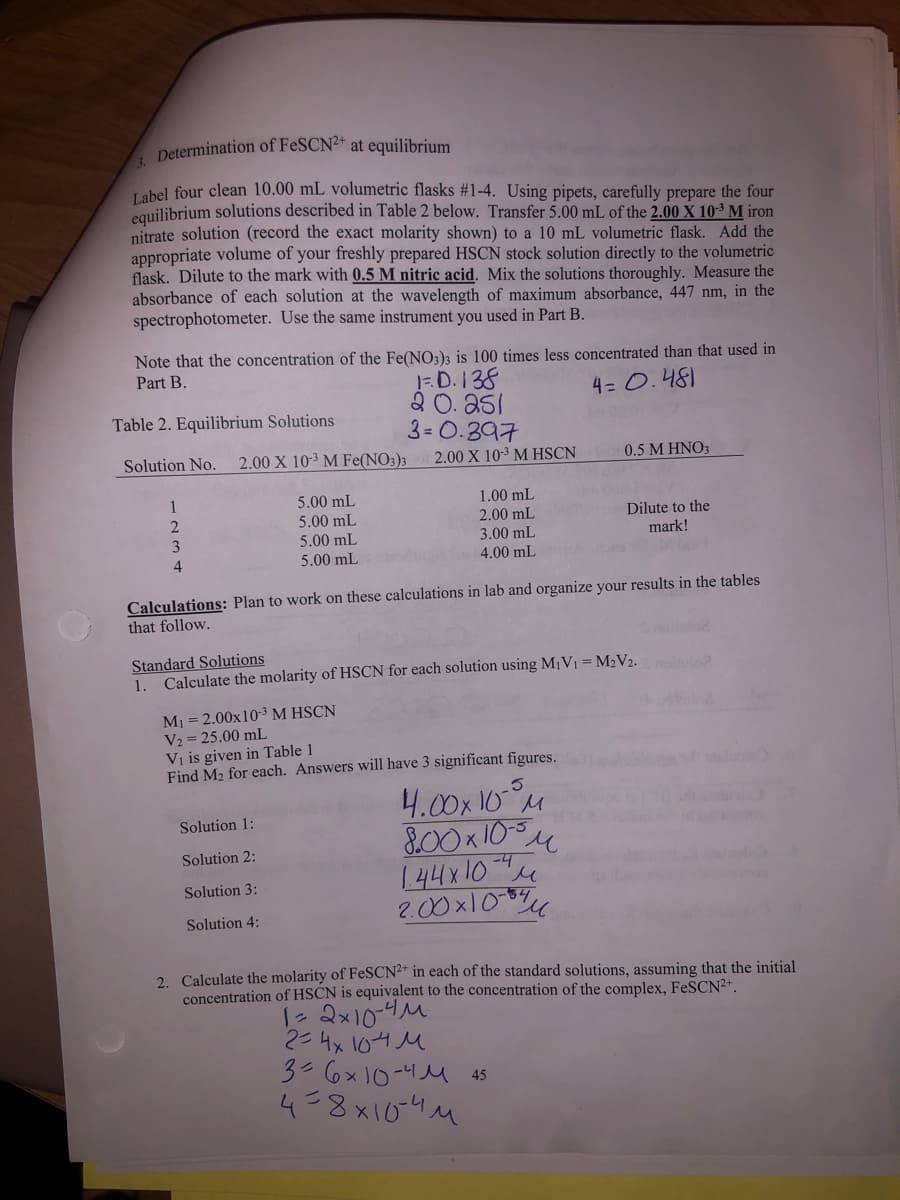5. Calculate the initial concentration of Fe³+ and HSCN in each solution. a. Calculate the initial concentration of Fe3+ using M1V1=M2V2. M1 = 2.00x10-³ M (Table 2) Vi = 5.00 mL V2= 10.00 mL 0.001 M b. Calculate the initial concentration of HSCN for each solution. M1 = 2.00x10-3 M HSCN V2 = 10.00 mL Vị is given in Table 2 Find M2 for each. Answers will have 3 significant figures. 0.0002 0.0004 0.0006 Solution 1: Solution 2: Solution 3: 0.0008 Solution 4:
5. Calculate the initial concentration of Fe³+ and HSCN in each solution. a. Calculate the initial concentration of Fe3+ using M1V1=M2V2. M1 = 2.00x10-³ M (Table 2) Vi = 5.00 mL V2= 10.00 mL 0.001 M b. Calculate the initial concentration of HSCN for each solution. M1 = 2.00x10-3 M HSCN V2 = 10.00 mL Vị is given in Table 2 Find M2 for each. Answers will have 3 significant figures. 0.0002 0.0004 0.0006 Solution 1: Solution 2: Solution 3: 0.0008 Solution 4:
Chapter9: Complexometric And Precipitation Titrations
Section: Chapter Questions
Problem 17P
Related questions
Question
I’m not sure if question 5a and 5b are right or not
![3. Plot the absorbance versus the [FESCN²+1. Calculate the slope of the linear regression line.
Graphical Analysis would make this easier.
Equilibrium solutions and Determination of the Equilibrium Constant
4. Using the absorbance values and your Beer's Law plot, determine the equilibrium
concentration of FeSCN²+. This is easily calculated from the slope and y-intercept values.
5. Calculate the initial concentration of Fe3+ and HSCN in each solution.
a. Calculate the initial concentration of Fe3+ using M1V1=M2V2.
M1 = 2.00x10-3 M (Table 2)
Vi = 5.00 mL
V2= 10.00 mL
0.001 M
b. Calculate the initial concentration of HSCN for each solution.
M1 = 2.00x10-³ M HSCN
V2 = 10.00 mL
Vị is given in Table 2
Find M2 for each. Answers will have 3 significant figures.
a del O.0002
Solution 1:
0.0004
0.0006
0.0008
Solution 2:
Solution 3:
Solution 4:
6. Calculate the equilibrium [Fe³*] and [HSCN] in each solution, using an equilibrium table.
Calculate the [H*] at equilibrium. Is the additional H* produced in the reaction significant
compared to the initial 0.5 M H* concentration?
7.](/v2/_next/image?url=https%3A%2F%2Fcontent.bartleby.com%2Fqna-images%2Fquestion%2F7906da6b-d6c5-41c1-8c5e-98af9e5b5db1%2F24579d15-4233-48f8-80b2-69855b62bf03%2Fdc1vqkv_processed.jpeg&w=3840&q=75)
Transcribed Image Text:3. Plot the absorbance versus the [FESCN²+1. Calculate the slope of the linear regression line.
Graphical Analysis would make this easier.
Equilibrium solutions and Determination of the Equilibrium Constant
4. Using the absorbance values and your Beer's Law plot, determine the equilibrium
concentration of FeSCN²+. This is easily calculated from the slope and y-intercept values.
5. Calculate the initial concentration of Fe3+ and HSCN in each solution.
a. Calculate the initial concentration of Fe3+ using M1V1=M2V2.
M1 = 2.00x10-3 M (Table 2)
Vi = 5.00 mL
V2= 10.00 mL
0.001 M
b. Calculate the initial concentration of HSCN for each solution.
M1 = 2.00x10-³ M HSCN
V2 = 10.00 mL
Vị is given in Table 2
Find M2 for each. Answers will have 3 significant figures.
a del O.0002
Solution 1:
0.0004
0.0006
0.0008
Solution 2:
Solution 3:
Solution 4:
6. Calculate the equilibrium [Fe³*] and [HSCN] in each solution, using an equilibrium table.
Calculate the [H*] at equilibrium. Is the additional H* produced in the reaction significant
compared to the initial 0.5 M H* concentration?
7.

Transcribed Image Text:. Determination of FeSCN²* at equilibrium
Label four clean 10.00 mL volumetric flasks #1-4. Using pipets, carefully prepare the four
couilibrium solutions described in Table 2 below. Transfer 5.00 mL of the 2.00 X 10³ M iron
nitrate solution (record the exact molarity shown) to a 10 mL volumetric flask. Add the
appropriate volume of your freshly prepared HSCN stock solution directly to the volumetric
flask. Dilute to the mark with 0.5 M nitric acid. Mix the solutions thoroughly. Measure the
absorbance of each solution at the wavelength of maximum absorbance, 447 nm, in the
spectrophotometer. Use the same instrument you used in Part B.
Note that the concentration of the Fe(NO3)3 is 100 times less concentrated than that used in
Part B.
1- D. 138
20. asI
3= 0.397
4=0.481
Table 2. Equilibrium Solutions
Solution No.
2.00 X 10-3 M Fe(NO3)3
2.00 X 10-3 M HSCN
0.5 M HNO3
5.00 mL
5.00 mL
1.00 mL
2.00 mL
3.00 mL
1
Dilute to the
mark!
3
5.00 mL
4.
5.00 mL
4.00 mL
Calculations: Plan to work on these calculations in lab and organize your results in the tables
that follow.
Standard Solutions
Calculate the molarity of HSCN for each solution using M¡V1 = M2V2.
1.
M1 = 2.00x10-³ M HSCN
V2 = 25.00 mL
Vị is given in Table 1
Find M2 for each. Answers will have 3 significant figures.
4.00x10 M
800x10M
144x10 4
2.00x10
Solution 1:
Solution 2:
-4
M.
54
Solution 3:
Solution 4:
2. Calculate the molarity of FESCN2* in each of the standard solutions, assuming that the initial
concentration of HSCN is equivalent to the concentration of the complex, FESCN²+.
1- 2x10-4M
2= 4x 104 M
3-6x10 -4 M 45
4=8x104M
Expert Solution
This question has been solved!
Explore an expertly crafted, step-by-step solution for a thorough understanding of key concepts.
This is a popular solution!
Trending now
This is a popular solution!
Step by step
Solved in 2 steps with 2 images

Knowledge Booster
Learn more about
Need a deep-dive on the concept behind this application? Look no further. Learn more about this topic, chemistry and related others by exploring similar questions and additional content below.Recommended textbooks for you


Principles of Instrumental Analysis
Chemistry
ISBN:
9781305577213
Author:
Douglas A. Skoog, F. James Holler, Stanley R. Crouch
Publisher:
Cengage Learning


Principles of Instrumental Analysis
Chemistry
ISBN:
9781305577213
Author:
Douglas A. Skoog, F. James Holler, Stanley R. Crouch
Publisher:
Cengage Learning